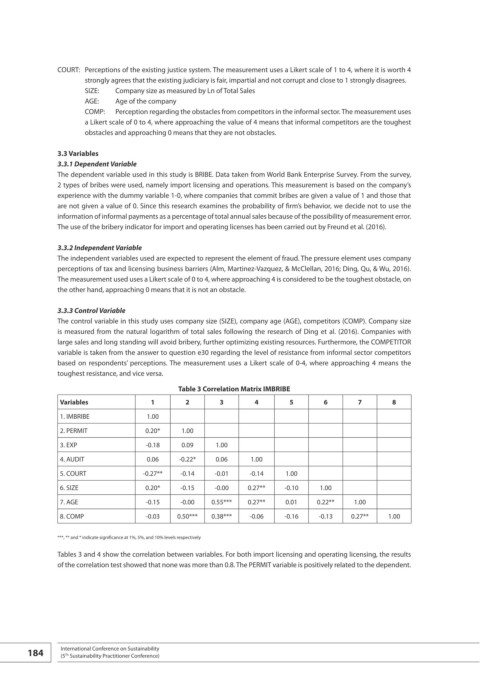Page 185 - SUSTAINABILITY ISSUES & COVID-19
P. 185
COURT: Perceptions of the existing justice system. The measurement uses a Likert scale of 1 to 4, where it is worth 4
strongly agrees that the existing judiciary is fair, impartial and not corrupt and close to 1 strongly disagrees.
SIZE: Company size as measured by Ln of Total Sales
AGE: Age of the company
COMP: Perception regarding the obstacles from competitors in the informal sector. The measurement uses
a Likert scale of 0 to 4, where approaching the value of 4 means that informal competitors are the toughest
obstacles and approaching 0 means that they are not obstacles.
3.3 Variables
3.3.1 Dependent Variable
The dependent variable used in this study is BRIBE. Data taken from World Bank Enterprise Survey. From the survey,
2 types of bribes were used, namely import licensing and operations. This measurement is based on the company’s
experience with the dummy variable 1-0, where companies that commit bribes are given a value of 1 and those that
are not given a value of 0. Since this research examines the probability of firm’s behavior, we decide not to use the
information of informal payments as a percentage of total annual sales because of the possibility of measurement error.
The use of the bribery indicator for import and operating licenses has been carried out by Freund et al. (2016).
3.3.2 Independent Variable
The independent variables used are expected to represent the element of fraud. The pressure element uses company
perceptions of tax and licensing business barriers (Alm, Martinez-Vazquez, & McClellan, 2016; Ding, Qu, & Wu, 2016).
The measurement used uses a Likert scale of 0 to 4, where approaching 4 is considered to be the toughest obstacle, on
the other hand, approaching 0 means that it is not an obstacle.
3.3.3 Control Variable
The control variable in this study uses company size (SIZE), company age (AGE), competitors (COMP). Company size
is measured from the natural logarithm of total sales following the research of Ding et al. (2016). Companies with
large sales and long standing will avoid bribery, further optimizing existing resources. Furthermore, the COMPETITOR
variable is taken from the answer to question e30 regarding the level of resistance from informal sector competitors
based on respondents’ perceptions. The measurement uses a Likert scale of 0-4, where approaching 4 means the
toughest resistance, and vice versa.
Table 3 Correlation Matrix IMBRIBE
Variables 1 2 3 4 5 6 7 8
1. IMBRIBE 1.00
2. PERMIT 0.20* 1.00
3. EXP -0.18 0.09 1.00
4. AUDIT 0.06 -0.22* 0.06 1.00
5. COURT -0.27** -0.14 -0.01 -0.14 1.00
6. SIZE 0.20* -0.15 -0.00 0.27** -0.10 1.00
7. AGE -0.15 -0.00 0.55*** 0.27** 0.01 0.22** 1.00
8. COMP -0.03 0.50*** 0.38*** -0.06 -0.16 -0.13 0.27** 1.00
***, ** and * indicate significance at 1%, 5%, and 10% levels respectively
Tables 3 and 4 show the correlation between variables. For both import licensing and operating licensing, the results
of the correlation test showed that none was more than 0.8. The PERMIT variable is positively related to the dependent.
184 International Conference on Sustainability
(5 Sustainability Practitioner Conference)
Th

